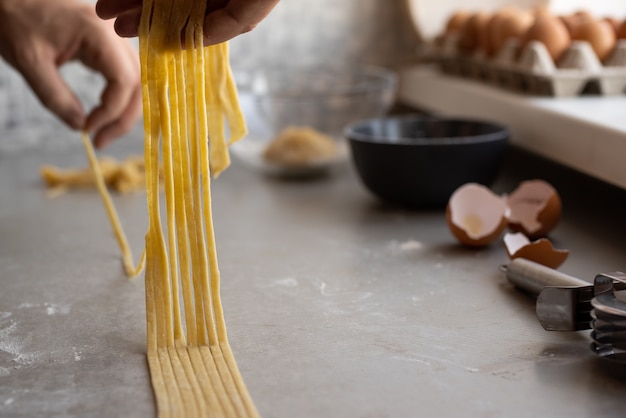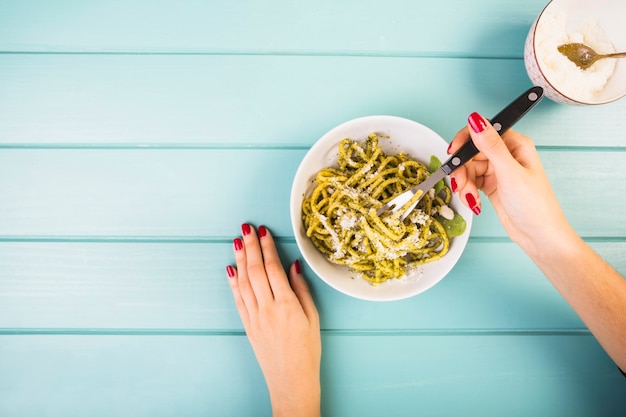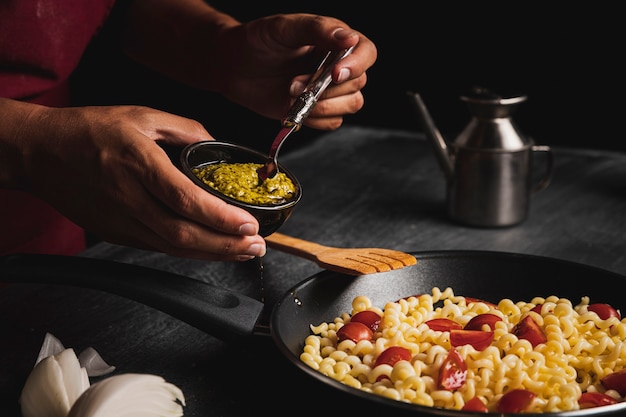Pasta. It’s a dish that brings people together. Whether you’re enjoying a simple weeknight meal or a fancy dinner party, pasta has a way of making everyone happy. But, let’s face it, we’ve all had those pasta disasters. The mushy pasta, the clumpy mess. It’s enough to make you want to give up on pasta altogether!
But, trust me, I’ve been there too. And, through trial and error (and a lot of delicious pasta!), I’ve learned the secrets to achieving perfect pasta, every time.
This guide isn’t just about recipes – it’s about understanding the fundamentals. It’s about building your confidence in the kitchen and transforming your pasta experience from frustrating to fabulous. We’ll start with the basics, dive into the art of cooking pasta, and then explore different types of pasta shapes and sauces. We’ll even tackle those common pasta pitfalls that can make even the most experienced cook cringe!
So, grab your apron, get ready to have fun, and let’s create some pasta magic together!
(Part 1) - The Essential Tools

You don’t need a gourmet kitchen to make amazing pasta. In fact, you can create incredible dishes with just a few essential tools. Here’s what I consider the foundation of any pasta-making arsenal:
1. A Large Pot
A good pot is your foundation. You want one that’s big enough to hold plenty of water – at least 6-8 quarts – and allows the pasta to cook freely. A thick base is also a must. It helps distribute the heat evenly so that your pasta cooks consistently. I recommend a pot made of stainless steel or enameled cast iron.
2. A Colander
This is your pasta’s escape route! Choose a colander with a wide base to accommodate your pasta and prevent it from spilling over the sides. I like to use a colander with a handle for easier lifting and draining.
3. A Wooden Spoon
This is your stirring companion! A wooden spoon is perfect for gently stirring the pasta as it cooks. It prevents the pasta from sticking together and creates a smooth and even texture. Plus, it’s gentler on your pasta than a metal spoon.
4. Measuring Cups and Spoons
Pasta is about precision! Accurate measurements are key to achieving the perfect balance of ingredients, especially when it comes to your sauce. Invest in a good set of measuring cups and spoons – they’ll be your go-to tools for all your culinary creations.
5. A Sharp Chef’s Knife
A sharp knife is a must for chopping vegetables, herbs, and other ingredients in your pasta dishes. A sharp knife makes for precise cuts and helps release the natural flavours of your ingredients.
(Part 2) - The Right Pasta for the Job

The world of pasta shapes is vast and exciting! Each shape is designed to work beautifully with certain sauces, so understanding this connection can elevate your pasta experience. Think of it like pairing wine with food.
Here are some of my all-time favourite pasta shapes and the sauces they love to dance with:
1. Spaghetti
Long, thin, and elegant, spaghetti is the ultimate classic. Its long strands perfectly capture light and delicate sauces, such as classic tomato sauces and pesto. Imagine twirling those strands onto your fork, coated in a vibrant green pesto. Pure bliss!
2. Penne
Penne, with its short, tube-like shape and ridges, is a champion at holding chunky sauces. Think hearty Bolognese with its ground meat and rich tomato sauce, or creamy alfredo sauce that coats the ridges with lusciousness. It’s a perfect match for any sauce that needs a little something to cling to.
3. Fettuccine
These long, flat ribbons are perfect for creamy sauces. Imagine the creamy mushroom sauce clinging to each ribbon, or a decadent seafood sauce with delicate shrimp and scallops. The flat surface of fettuccine allows the sauce to coat it beautifully, creating a truly luxurious experience.
4. Rigatoni
Rigatoni is another short, tube-shaped pasta with a distinct characteristic: ridges on the outside. These ridges are like tiny sauce traps, ideal for hearty meat sauces and rich vegetable ragouts. The ridges catch the sauce, making every bite bursting with flavour.
5. Orecchiette
These small, ear-shaped pasta are designed to catch every bit of sauce, herb, and vegetable. They’re perfect for lighter sauces like pesto, simple tomato sauce, or a fresh and vibrant spring vegetable sauce. They add a playful touch to any dish.
(Part 3) - The Art of Cooking Pasta

Cooking pasta might seem simple, but there’s an art to it. Just like a skilled painter uses the right brushstrokes, we need to use the right techniques to achieve the perfect texture and flavour.
Here’s my step-by-step guide for cooking pasta like a pro:
1. Use Plenty of Water
Imagine your pasta swimming freely. That’s what we want! Use at least 6-8 quarts of water for every pound of pasta. This ensures the pasta cooks evenly and prevents the water temperature from plummeting when the pasta is added.
2. Salt the Water
This is a crucial step! Salt adds flavour and helps to draw out the natural sweetness of the pasta. The water should taste like seawater – about 1 tablespoon of salt for every 4 quarts of water.
3. Bring the Water to a Rolling Boil
Before adding your pasta, make sure the water is boiling vigorously. This high heat ensures the pasta cooks evenly and quickly.
4. Add the Pasta
Gently add the pasta to the boiling water, making sure it’s fully submerged. Stir the pasta a few times to prevent it from sticking together.
5. Cook According to Package Directions
Each pasta shape has a different cooking time. Read the package instructions and follow them diligently. Remember, we’re looking for al dente pasta – firm to the bite. The pasta should have a slight resistance when you chew it. If it’s too soft, it’s overcooked.
6. Don’t Overcook the Pasta
Overcooked pasta becomes mushy and loses its shape. It’s a common mistake, so keep a close eye on your pasta. Taste-test it about a minute or two before the suggested time.
7. Drain the Pasta
When the pasta is al dente, drain it in a colander. If you’re going to use the pasta water for your sauce (more on that later!), save about a cup of the hot water before draining. This starchy water adds richness and body to your sauce.
(Part 4) - The Perfect pasta sauce
Let’s talk about the magic ingredient: the sauce! It’s the heart and soul of your pasta dish. Think of it as a symphony of flavours that you get to create.
We’re going to explore different types of pasta sauces, share tips for making them, and reveal some of my favourite flavour combinations. Get ready to unleash your inner chef!
1. Tomato-Based Sauces
Tomato sauces are classic for a reason. They’re simple, versatile, and full of flavour.
- Simple Tomato Sauce: This is the foundation for countless pasta dishes. It’s made with crushed tomatoes, onions, garlic, and herbs. You can add your favourite spices and adjust the seasonings to suit your taste.
- Arrabbiata Sauce: This fiery tomato sauce is perfect for those who love a kick! It’s made with crushed tomatoes, red pepper flakes, garlic, and herbs. The red pepper flakes provide a spicy, warm flavour that will ignite your taste buds.
- Puttanesca Sauce: This bold and complex sauce has a rich history and a unique combination of flavours. It’s made with tomatoes, capers, olives, garlic, and anchovies. The salty, briny flavours of capers and olives create a delightful contrast with the sweetness of the tomatoes.
2. Creamy Sauces
Creamy sauces are rich and indulgent. They’re the perfect pairing for heavier pasta shapes like fettuccine or rigatoni. Think of them as a hug in a bowl!
- Alfredo Sauce: This classic sauce is made with butter, Parmesan cheese, and heavy cream. It’s a luxurious and comforting dish. Be sure to use high-quality Parmesan cheese for the best flavour.
- Carbonara Sauce: This Italian classic is made with eggs, pancetta, Parmesan cheese, and black pepper. It’s a simple but flavorful sauce that's perfect for spaghetti. The key to a good carbonara is to cook the eggs gently to create a creamy, silky sauce.
- Mushroom Cream Sauce: This sauce is a delightful combination of earthy mushrooms and creamy richness. It’s made with sautéed mushrooms, heavy cream, and Parmesan cheese.
3. Pesto Sauces
Pesto sauces are vibrant and full of fresh, herbaceous flavours. They’re typically made with fresh basil, pine nuts, garlic, olive oil, and Parmesan cheese.
- Classic Pesto: This pesto is the gold standard! It’s made with fresh basil, pine nuts, garlic, olive oil, and Parmesan cheese. It's versatile and can be used with various pasta shapes.
- Red Pesto: This pesto brings a delightful twist with its bright red hue. It’s made with roasted red peppers, pine nuts, garlic, olive oil, and Parmesan cheese. It’s a vibrant and flavourful sauce that’s perfect for pasta.
- Walnut Pesto: This pesto is a nutty and delicious alternative to traditional pesto. It’s made with walnuts, garlic, olive oil, and Parmesan cheese. The walnuts add a depth of flavour and a slightly sweet note.
(Part 5) - Mastering the Art of Sauce Making
Cooking a sauce is a journey. It’s about letting the flavours develop and finding that perfect balance. Here are some tips that can help you achieve delicious results every time:
1. Start with Quality Ingredients
Just like a painter uses the best paints, we need to use the best ingredients. Fresh, high-quality tomatoes, herbs, and spices are essential for a delicious and flavorful sauce. Don’t be afraid to splurge on quality ingredients – it makes all the difference.
2. Don’t Overcook the Sauce
Overcooked sauce can become bitter and lose its flavour. Keep a close eye on it and remove it from the heat as soon as it reaches the desired consistency. If you’re using fresh tomatoes, simmer them gently until they soften, but don’t overcook them.
3. Adjust the Seasoning
Taste your sauce frequently as you cook and adjust the seasoning as needed. Don’t be afraid to experiment with different herbs and spices to create your own unique flavours.
4. Use Pasta Water to Enhance the Sauce
This is a secret that chefs use! Adding a cup or two of starchy pasta water to your sauce helps to thicken it and adds a burst of flavour. It’s a simple trick that makes a big difference.
5. Let the Sauce Rest
Allow the sauce to rest for a few minutes before serving. This lets the flavours meld together and creates a more harmonious taste.
(Part 6) - Elevate Your Pasta with Toppings
Think of your pasta as a blank canvas. Toppings are the brushstrokes that add colour, texture, and personality. Here are some of my go-to toppings that take pasta to the next level:
1. Fresh Herbs
A sprinkle of fresh parsley, basil, oregano, or thyme can transform a simple pasta dish. They add a bright, fresh flavour and a beautiful touch of colour. The aroma alone is enough to make your mouth water!
2. Cheese
Cheese is a pasta classic. Parmesan cheese is a staple, but don’t be afraid to experiment with other cheeses, like ricotta, mozzarella, or even goat cheese.
3. Roasted Vegetables
Roasted vegetables, such as bell peppers, zucchini, or asparagus, add a burst of flavour and texture to your pasta. The roasting process brings out the natural sweetness of the vegetables and adds a delicious caramelized touch.
4. Nuts and Seeds
Toasted pine nuts, walnuts, or sunflower seeds add a delightful crunch and nutty flavour. They’re particularly nice with pesto sauces, adding a textural contrast and a boost of flavour.
5. Chili Flakes
A pinch of chili flakes adds a touch of heat and depth of flavour to any pasta dish. It’s a great way to add a little kick without overpowering the other flavours.
(Part 7) - Common Pasta Pitfalls and How to Avoid Them
We all make mistakes in the kitchen. It’s part of the learning process! But, there are some common pasta pitfalls that we can easily avoid with a few simple tips.
1. Overcooked Pasta
Overcooked pasta is mushy and bland. To avoid this, cook the pasta according to package directions and taste-test it a minute or two before the suggested time. Remember, we’re aiming for al dente – firm to the bite.
2. Sticky Pasta
Sticky pasta happens when the pasta sticks together during cooking. To avoid this, use plenty of water and stir the pasta occasionally while it cooks. The water should be bubbling vigorously to prevent sticking.
3. Undercooked Pasta
Undercooked pasta can be tough and chewy. To avoid this, cook the pasta according to package directions and taste-test it to make sure it’s cooked through.
4. Unevenly Cooked Pasta
Unevenly cooked pasta happens when the water temperature drops too much. To avoid this, use plenty of water and bring it to a rolling boil before adding the pasta.
5. Too Much Sauce
Too much sauce can make your pasta soggy. To avoid this, use just enough sauce to coat the pasta. If you have leftover sauce, serve it on the side for those who want extra sauce.
(Part 8) - FAQs
I know you might have some questions about pasta. Here are answers to some of the most common ones:
1. What is the best way to store pasta?
Store pasta in an airtight container in a cool, dry place. It will last for several months, but the flavour and texture will be best if you use it within a year.
2. Can I freeze pasta?
Yes, you can freeze cooked pasta. To freeze it, toss it with a little bit of olive oil and freeze in a freezer-safe bag. It will last for up to 3 months in the freezer.
3. How do I reheat pasta?
The best way to reheat pasta is in a skillet with a little bit of olive oil or water. You can also reheat it in the microwave, but it may become a little mushy.
4. How do I make pasta sauce ahead of time?
You can make pasta sauce ahead of time and store it in the refrigerator for up to 3 days. If you want to freeze it, make sure to cool it completely before freezing in a freezer-safe container. It will last for up to 3 months in the freezer.
5. What are some tips for making a great pasta dish?
The key to a great pasta dish is using high-quality ingredients, cooking the pasta perfectly, and creating a delicious sauce. Don’t be afraid to experiment with different flavours and toppings. Let your creativity shine!
(Part 9) - The Pasta Journey Continues
There you have it, my friends! The key to mastering the art of pasta is about understanding the fundamentals and letting your creativity take over. Now that you’ve armed yourself with these tips and tricks, I encourage you to step into your kitchen, embrace the process, and unleash your inner pasta maestro.
Happy cooking!
Everyone is watching

How to Cook Frozen Lobster Tails Perfectly: A Step-by-Step Guide
RecipesLobster. Just the word conjures up images of lavish meals, special occasions, and a taste of luxury. But let's...

Pork Fillet Cooking Time: How Long to Cook It Perfectly
RecipesPork fillet, or tenderloin as it's sometimes called, is a real favourite in our house. It's so versatile, and...

Pigs in a Blanket Cooking Time: How Long to Bake for Perfect Results
RecipesAh, pigs in a blanket. Just the name conjures up images of those delightful little parcels of crispy pastry en...

The Ultimate Guide to Cooking Delicious Frankfurters
RecipesLet's face it, we all love a good frankfurter. It's a classic, simple, and always satisfying. But let's be rea...

Wolf Meat Recipes: A Guide to Cooking Wild Game
RecipesLet's be honest, you don't see wolf meat at your local butcher shop every day. It's a bit of a wild card, but ...
